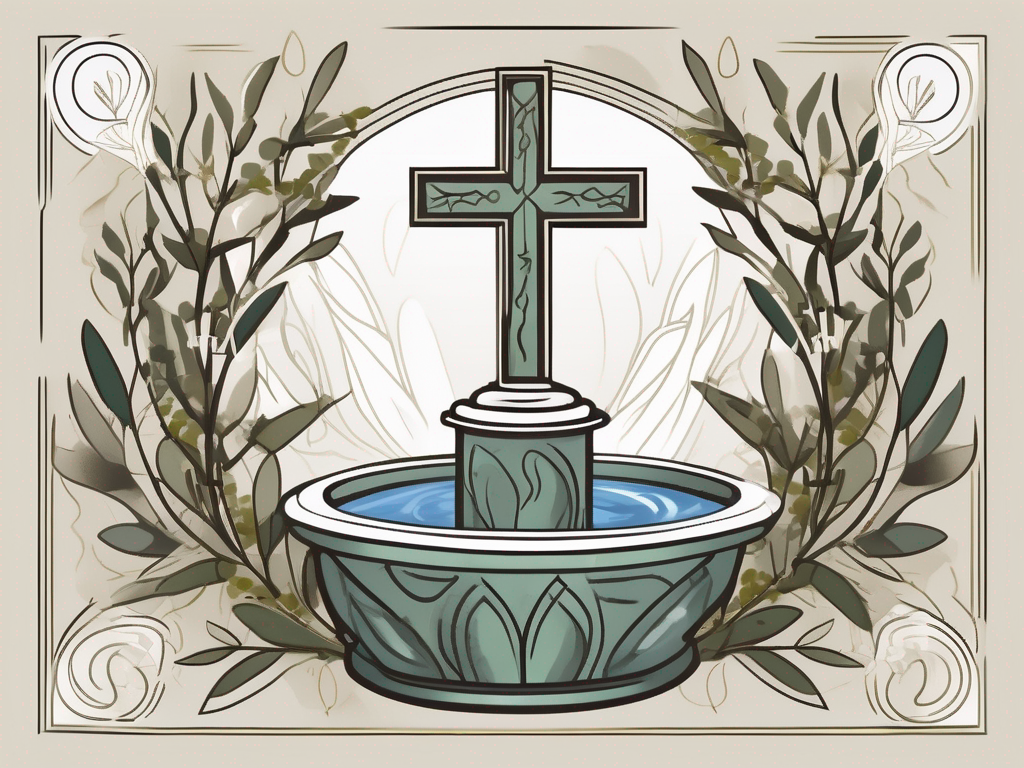In Christianity, baptism is a significant sacrament that holds great meaning for believers. It is a sacred ritual through which individuals publicly declare their faith and receive the forgiveness of sins. But what does the Bible say about being baptized? Let’s explore this topic and delve into the biblical teachings surrounding baptism.
Understanding the Concept of Baptism
Baptism is more than just a ceremonial act; it carries deep spiritual significance. Biblically, baptism is described as a symbolic act of dying to one’s old self and being raised to new life in Christ. This act represents a believer’s identification with Jesus’ death, burial, and resurrection.
Additionally, baptism serves as an outward sign of an inward change. It is a public proclamation of faith and an initiation into the Christian community. By being baptized, individuals publicly declare their commitment to following Christ and becoming part of His Church.
When we delve into the concept of baptism, we uncover a multitude of layers that add depth and meaning to this sacred act. Let’s explore further.
Biblical Definition of Baptism
According to the Bible, baptism is the immersion of a believer in water. The act of immersion represents the complete submersion and emergence of the individual, symbolizing their burial and resurrection with Christ. This form of baptism is evident in various instances throughout the New Testament.
One such instance is found in the Gospel of Matthew, where John the Baptist baptizes Jesus in the Jordan River. As Jesus emerges from the water, the heavens open, and the Holy Spirit descends upon Him like a dove. This powerful imagery emphasizes the divine significance of baptism and its connection to the work of the Holy Spirit.
Another biblical example is the Ethiopian eunuch in the book of Acts. Philip, guided by the Holy Spirit, encounters the eunuch who is reading from the book of Isaiah. Philip explains the Scriptures to him, and upon understanding, the eunuch asks to be baptized. They both go down into the water, and Philip baptizes him. This account highlights the importance of baptism as a response to the Gospel message and the role of discipleship in the baptismal process.
The Symbolism of Baptism in Christianity
Baptism carries rich symbolism for Christians. It signifies the washing away of sins and the purification of the soul. Just as water cleanses and refreshes the body, baptism represents the spiritual cleansing and renewal that occurs through faith in Christ.
Moreover, baptism represents a believer’s adoption into God’s family. It symbolizes the believer’s union with Christ and their participation in His death and resurrection. Through baptism, Christians are united with Christ and become partakers of God’s promises and blessings.
When we examine the symbolism of baptism, we find parallels in the Old Testament. The crossing of the Red Sea by the Israelites, led by Moses, can be seen as a foreshadowing of baptism. As the Israelites passed through the parted waters, they left behind their bondage in Egypt and entered into a new life of freedom. Similarly, through baptism, believers leave behind their old lives of sin and enter into a new life in Christ.
Furthermore, baptism is often associated with the concept of regeneration. Just as a caterpillar undergoes a transformation and emerges as a beautiful butterfly, baptism represents the spiritual transformation and new identity that believers experience in Christ.
In conclusion, baptism is a profound and multifaceted practice in Christianity. It encompasses the believer’s identification with Christ’s death and resurrection, serves as a public proclamation of faith, and symbolizes the washing away of sins and the believer’s adoption into God’s family. Through baptism, believers embark on a journey of spiritual renewal and transformation, embracing their new life in Christ.
Biblical References to Baptism
The New Testament contains several references to baptism, highlighting its importance in the Christian faith.
Baptism is a significant sacrament in Christianity, symbolizing the believer’s identification with Jesus Christ’s death, burial, and resurrection. It is a public declaration of faith and a crucial step in one’s spiritual journey.
Baptism in the New Testament
In the New Testament, we find numerous examples of baptism. Jesus Himself was baptized by John the Baptist, setting an example for His followers. Jesus’ baptism marked the beginning of His public ministry and emphasized the importance of baptism as an act of obedience and identification with God.
When Jesus emerged from the waters of the Jordan River, the heavens opened, and the Spirit of God descended upon Him like a dove. This event not only affirmed Jesus’ divine nature but also demonstrated the significance of baptism as a spiritual transformation and empowerment.
The apostles also emphasized the significance of baptism. In Acts chapter 2, after Peter’s sermon on the day of Pentecost, many people were baptized as a response to their faith in Jesus. Throughout the early church, baptism was a crucial part of a believer’s journey and their commitment to following Christ.
Baptism was not merely a ritual or a symbolic act but a transformative experience. It signified the believer’s union with Christ, their participation in His death and resurrection, and their cleansing from sin. Through baptism, believers publicly declared their faith in Jesus and their desire to live a new life in Him.
Baptism in the Old Testament
While the term “baptism” is not explicitly used in the Old Testament, we can find foreshadowings of baptism through various events and rituals. For instance, the crossing of the Red Sea by the Israelites symbolizes a type of baptism. As they passed through the waters, they were delivered from slavery and entered into a new life with God.
Another significant event that foreshadows baptism is the story of Noah and the ark. When God brought judgment upon the wickedness of the world through the flood, Noah and his family were saved by entering the ark. The ark, in a sense, served as a vessel of salvation, just as baptism symbolizes our salvation in Christ.
Furthermore, the Old Testament rituals of purification and cleansing also bear similarities to baptism. The ceremonial washings and anointings performed by the priests and the ritual cleansing of lepers and those who had come into contact with the dead all point to the need for spiritual purification and renewal.
While these events and rituals in the Old Testament do not explicitly use the term “baptism,” they provide a foundation and foreshadowing for the significance of baptism in the New Testament. They illustrate the spiritual truths and concepts that baptism represents, emphasizing the believer’s need for redemption, purification, and newness of life.
The Importance of Baptism in Christianity
Baptism holds great importance in the Christian faith. It is a significant step in one’s spiritual journey and plays a crucial role in a believer’s relationship with God.
But what exactly is the spiritual significance of baptism? It goes beyond just a physical act; it is a profound spiritual experience. When a person is baptized, it symbolizes their participation in the death and resurrection of Christ. Just as Jesus died and rose again, baptism signifies that believers have died to their old selves and have been raised to new life in Him.
Furthermore, baptism is a powerful symbol of cleansing and forgiveness. Through this sacrament, individuals are washed clean of their sins and receive the gift of the Holy Spirit. The Holy Spirit, in turn, empowers believers to live a transformed life, guided by the teachings of Jesus.
Another aspect of baptism is its role as a mark of spiritual rebirth. When someone is baptized, it signifies their new life in Christ and their status as a child of God. It is a public declaration of their faith in Jesus and their commitment to follow Him. By publicly declaring their faith through baptism, Christians invite others to witness their transformation and consider the claims of Christianity.
Moreover, baptism is not just an individual act; it is a communal experience. When someone is baptized, they become part of the Christian community. This community provides a network of support, encouragement, and accountability as believers grow in their faith. Baptism connects individuals with other believers who share the same commitment to follow Jesus, fostering a sense of belonging and unity.
In conclusion, baptism is a deeply meaningful and significant practice in Christianity. It represents spiritual rebirth, cleansing, and the believer’s public declaration of faith. It is a step that connects individuals with the Christian community and provides a foundation for their ongoing spiritual journey.
Different Forms of Baptism in the Bible
While immersion baptism is the primary form of baptism described in the Bible, there are instances where other forms are mentioned.
One such form is known as pouring baptism. This method involves the pouring of water over the head of the individual being baptized, symbolizing the cleansing and renewal of their spirit. Pouring baptism is often seen as a practical alternative to immersion, especially in situations where full submersion may not be possible, such as in cases of illness or physical limitations.
Another form of baptism mentioned in the Bible is known as sprinkling baptism. This practice involves the sprinkling of water onto the person being baptized, symbolizing the washing away of sin and the gift of the Holy Spirit. Sprinkling baptism is often associated with the Old Testament practice of ceremonial cleansing, where water was sprinkled on individuals to purify them.
Immersion Baptism
As mentioned earlier, immersion baptism is the most prevalent form of baptism seen in the Bible. Immersion involves the complete submersion of a believer in water, symbolizing the death and burial of the old self and the resurrection to new life in Christ. This form of baptism best reflects the biblical teachings and is commonly practiced by many Christian denominations.
When an individual is immersed in water, it represents their identification with Jesus’ death and burial. As they are raised out of the water, it symbolizes their identification with His resurrection and new life. Immersion baptism is seen as a powerful and transformative experience, as it visually portrays the believer’s union with Christ and their commitment to follow Him.
Throughout history, immersion baptism has been practiced in various ways. In some traditions, baptismal pools or natural bodies of water, such as rivers or lakes, are used for the immersion. The person being baptized may walk into the water or be led by a minister, who then immerses them fully. Other traditions use a baptismal font or a specially designed baptistery within a church building, where the individual is lowered into the water.
Infant Baptism
Although not explicitly described in the Bible, some Christian traditions practice infant baptism. This form of baptism involves the sprinkling or pouring of water on infants as a sign of their dedication to God and their inclusion in the covenant community. Different interpretations and beliefs exist regarding infant baptism, and it often varies among denominations.
Infant baptism is rooted in the belief that God’s grace is extended to children, even before they are able to understand or make a personal decision to follow Christ. It is seen as a way of welcoming them into the faith community and entrusting them to God’s care. This practice is often accompanied by the commitment of parents and sponsors to raise the child in the teachings of the Christian faith.
While some argue that infant baptism should be reserved for those who are old enough to profess their own faith, others believe that it is a means of initiating children into the faith and providing them with spiritual guidance from an early age. The theological and practical implications of infant baptism continue to be debated among Christians, leading to a diversity of practices and beliefs.
Common Misconceptions About Baptism
Baptism has been the subject of various misunderstandings and debates throughout church history. Let’s address a couple of common misconceptions surrounding baptism.
Is Baptism Necessary for Salvation?
While baptism is an essential step in a believer’s journey, it is not the sole requirement for salvation. The Bible teaches that salvation comes through faith in Jesus Christ alone. Baptism is an outward expression of an inward transformation that has already taken place through faith. It is a response to salvation, signifying one’s commitment to follow Christ.
The Role of Baptism in Forgiveness of Sins
Baptism is closely connected to the forgiveness of sins; however, it does not guarantee automatic forgiveness. The forgiveness of sins comes through faith in Jesus and His sacrificial death on the cross. Baptism serves as a powerful symbol of the cleansing and forgiveness of sins that believers receive through faith in Christ.
In conclusion, the Bible holds valuable teachings on the topic of baptism. It underscores the spiritual significance of this sacrament, highlighting its role in the believer’s relationship with God and their journey of faith. Baptism represents a public declaration of an individual’s commitment to follow Christ and a reminder of the transformative power of God’s grace in their life.












